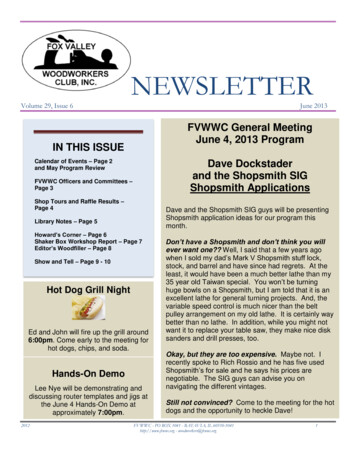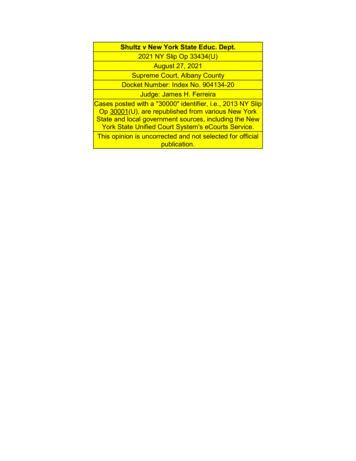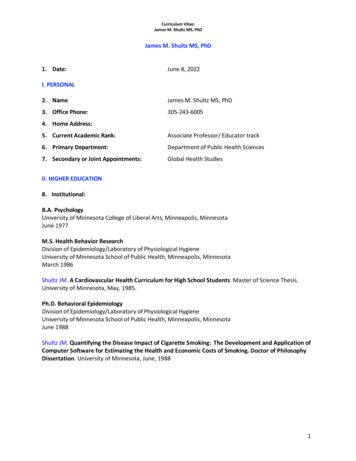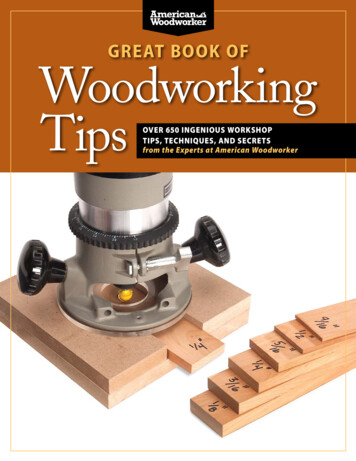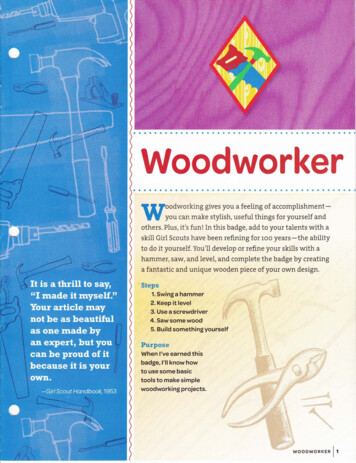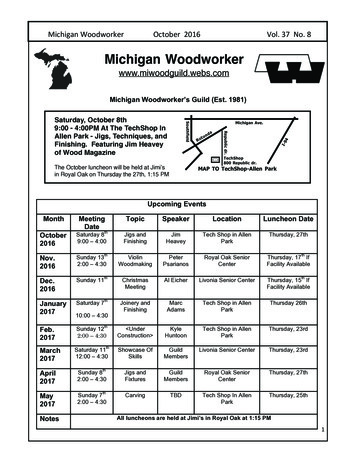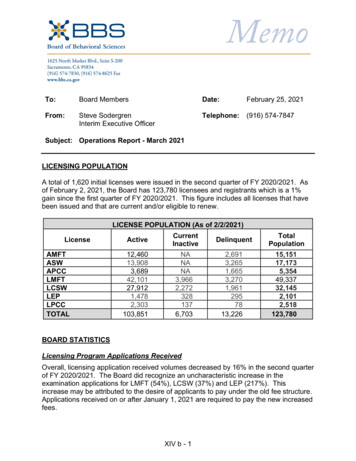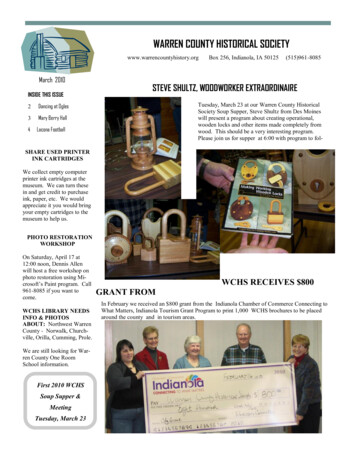
Transcription
WARREN COUNTY HISTORICAL SOCIETYwww.warrencountyhistory.orgMarch 2010INSIDE THIS ISSUE Dancing at Ogles Mary Berry Hall4Lacona FootballBox 256, Indianola, IA 50125(515)961-8085STEVE SHULTZ, WOODWORKER EXTRAORDINAIRETuesday, March 23 at our Warren County HistoricalSociety Soup Supper, Steve Shultz from Des Moineswill present a program about creating operational,wooden locks and other items made completely fromwood. This should be a very interesting program.Please join us for supper at 6:00 with program to fol-SHARE USED PRINTERINK CARTRIDGESWe collect empty computerprinter ink cartridges at themuseum. We can turn thesein and get credit to purchaseink, paper, etc. We wouldappreciate it you would bringyour empty cartridges to themuseum to help us.PHOTO RESTORATIONWORKSHOPOn Saturday, April 17 at12:00 noon, Dennis Allenwill host a free workshop onphoto restoration using Microsoft’s Paint program. Call961-8085 if you want tocome.WCHS LIBRARY NEEDSINFO & PHOTOSABOUT: Northwest WarrenCounty - Norwalk, Churchville, Orilla, Cumming, Prole.We are still looking for Warren County One RoomSchool information.First 2010 WCHSSoup Supper &MeetingTuesday, March 23WCHS RECEIVES 800GRANT FROMIn February we received an 800 grant from the Indianola Chamber of Commerce Connecting toWhat Matters, Indianola Tourism Grant Program to print 1,000 WCHS brochures to be placedaround the county and in tourism areas.
WARREN COUNTY HISTORICAL SOCIETYDANCE FEVER, Excerpt from “Winginamen”, Indianola High School 1983, by Marc KingeryLog Cabin builtby Loddie OgleIt’s Saturday night. Small groups of people traveldown a country road toward a little farm house. In thedistance can be heard the gay chords of a fiddle andthe strumming of a banjo. Through the twilight, distant sounds of people dancing and laughing. “Thetimes were rough and money was hard to come by,”said Edith Conn, Research Director of the WarrenCounty Historical society. But one night at LoddieOgle’s Log Cabin Dance Hall is all that is needed toforget the dim present and cut loose for a night of funand excitement.SECLUDEDToday the dance hall no longer exists, having beenovercome by fire, but the log house and tourists’homes still stand. Loddie Ogle first started the tourists’ homes in the early thirties, during the Great Depression. They are located approximately ten milessouth of Indianola and one mile west on an old country road in a secluded area. The trees stand tall andfull, screening the sunlight. The old rustic log housesits by itself, looking as though it has a million storiesto tell.After building the tourists’ homes, Mrs. Ogle built alog cabin dance hall. People from all over the countyand even from Des Moines would come to dance tothe country hoe-down music of Earl May of Shenandoah, and other local bands.BOOTLEG EASY TO COME BYNot only did some people come to dance but also tofeast on some good home cooking of Mrs. Ogle, especially her famous chicken sandwich. It was rumoredthat if anyone needed to wash those sandwiches down,there was a good chance among some of the guests tofind some bootleg whiskey, even though it was a federal crime during the days of prohibition.According to Mrs. Conn the dance hall allowed peopleto relax and get away fromLog Cabin Festival Meetingtheir troubles. It was aninexpensive way to takeMonday, April 12the family out and forget5:30 pmabout the economicallyJoin us it you want to help .hard times during the“Dirty Thirties.”
WARREN COUNTY HISTORICAL SOCIETYMARY ERRY HALL, SIMPSON COLLEGEPage 3Photo: Mary Berry Hall before 1914Mary Berry Hall, originally named “Ladies Boarding Hall,” was built in 1890 as Simpson College’s first residence hall for students. It opened for 64 students and one matron in January 1891 and served as a residence hall for students until 1967. During itsnearly 120 year history, Mary Berry Hall has served as a residence home for young women, a coed dormitory, a bookstore, faculty offices, classrooms, art gallery, and other uses.In 1887 the Simpson College Board of Trustees voted to build a residence hall for young woman but agreed not to start construction until at least 10,000 of the estimated 15,000 construction cost had been raised. Vice President Fletcher Brown(President, 1892-98) devised a plan to name the 32 sleeping rooms after donors who pledged 250; it took two years of hard workto accomplish the fund raising goal. Willis Proudfoot drew up plans for the new building and E. W. Fortney and Son wereawarded the contract to build in 1889. Approximately 90,000 bricks were used to build the massive fortress-like three storybuilding. The ground floor included a dining hall; the first floor featured an attractive lounge (where young men could visit), thematron’s suite, and sleeping rooms; the top floor contained additional sleeping accommodations. Under the pitched attic therewas storage area.After remodeling, on November 8, 1908, Ladies Boarding Hall was renamed“Mary Berry Hall” after a “one of Simpson’s most loved and respected undergraduates.” On January 28, 1902, Mary Berry, died from complications after surgery forappendicitis. For years she had suffered the same congenital disease that took herfather, Thomas S. Berry, President, Simpson College 1878-80, when she was onlythree. After her mother died a few months later, Mary Berry was raised until age 10by her uncle and aunt Captain and Mrs. B.C. Berry and then by the William H. Berryfamily. She was a member of Delta Delta Delta and, when she died, left half of her 3,622.12 estate to Simpson College for the purchase of scientific equipment.” TheBerry family played an important role in the early development and success of Simpson College.Source: Beneath the Whispering Maples: The History of Simpson College byJoseph W. Walt, Simpson College Press, 1995GEORGE & CATHY HLADKY’S BOUND ISSUES OF THEINDIANOLA REMINDER HAVE BEEN DONATED TO WCHS.THEY ARE AVAILABLE FOR RESEARCH PURPOSES.MA TUCKER MATRON LADIES’ HALL
WARREN COUNTY HISTORICAL SOCIETY1940 SNOWBALL ING INCIDENTPage 41940 SNOWBALLING INCIDENTThirty-three Indianola junior high boys and girls received three blows each from a leather strap for disobeying written and verbal directives not to throw snowballs in front ofthe school building where people pass. The snowballing incident occurred at recessTuesday noon, February 20, 1940. Four teachers—Thomas Anderson, Vaughn Manners, George Dorr, and James Kennedy— administered the punishment. Several parentsprotested and met with school authorities. Superintendent W. H. Hoyman, said he didnot approve of the whipping. The School Board quickly adopted new rules on whipping indicating that corporal punishment should be rare and administered only in very exceptional cases. The new rulesstated that corporal punishment should be approved and under the direction of the principal [Walter Townsend] and thatno student should be punished in front of other students.According to the February 23, 1940 issue of The Indianola Record, the following students were disciplined: DaleDowney, Homer Needles, Carroll Norris, Bob Crabb, Ralph Dunn, Blaine Shupe, Clyde Jones, Bob Heaivilin, CharlesStockton, Bud Morris, Bob Mock, Landes Poling, Ivan Carpenter. Russell Murray, Duane Clark, Bob Sones, CarmenFerree, Bill Beck, Paul Jones, Bob Smith, Don Parsons, Bob Parsons, Bob Haworth, Bill Hoover, Jim Labertew, DavidPickard, Carolyn Anderson, Max Hill, Mary Van Vliet, Betty Lee Smith, and Norman and Laverne Hooper. Jean Burrows and Donna Lea Duncan turned themselves in when they heard their classmates were being punished.Teacher Manners explained the students were punished for disobeying school rules, not snowballing . “Children whodo not learn obedience and obey rules may become anarchists,” he asserted. He also claimed that some children laughedat the punishment then went home and told their parents who became incensed.LACONA FOOTBALLLacona Football, 1912. Back Row: Jake Smith, Randal Kessler, Paul Bowles, Ray Shupe, Billy Goode, OttoBennet, Front Row: Otto Sones, Ben Williams, Fred Hoffman, Frank McClure, Leo Kessler, George Williams, JimKimsey, Dave Williams
WARREN COUNTY HISTORICAL SOCIETYPage 5HELP CREATE A WARREN COUNTY HISTORICAL SOCIETY COOKBOOKWe are creating a WCHS Cookbook as a fundraiser in 2010. We need your help. Please share your favorite recipes withus. Fill out the following form and return to the Warren County Historical Society by May 15th. You may submit asmany recipes as you wish. If there is a family or prize winning story about a particular recipe, please share this with us.Examples: recipe came from Grandma Moses and we had it every Thanksgiving; this recipe won a blue ribbon at theIowa State Fair; I created this recipe to meet my son’s special dietary needs; this recipe came from the Methodist Churchand became a family favorite; this is a healthy low fat alternative; CIPE NAME:COMMENTS:INGREDIENTS:DIRECTIONS:YOUR NAME:FIRST WCHS 2010 MEETING*SOUP SUPPERTuesday, March 23 at 6:00 pmThe Iowa History Center at Simpson Presents:Douglas Bauer, and his memoir: Prairie City, IowaThree Seasons at HomeLekberg Hall, Simpson CollegeTuesday, March 307:00 pm
.WARREN COUNTY HISTORICAL SOCIETYPROPOSED 2010 BUDGETChecking balance as of 1-1-2010RceiptsGeneral FundDonationsRentCopiesMembershipWarren County Board of Supervisors AppropriationMemorialsIndianola PTOCity of Indianola for Handicap AccessGrant for BrochuresGrant for Handicap AccessibilityTotal General Fund ReceiptsLog Cabin Festival ReceiptsGrand Total of all ReceiptsDisbursementsGeneral FundBank lock boxPost Office rentMowingTelephoneLights, water, sewerGasInsurancePostageSuppliesSoftware & trainingChamber of Commerce Dues*Handicap EntranceBrochuresNewslettersTotal General Fund DisbursementsLog Cabin Festival DisbursementsWarren County Modular RR-GrantTotal for all DisbursementsBalance 12/31/2010 00.001,000.00800.004,800.00 13,265.0010,000.00 23,265.00 .004,000.001,467.3527,650.356,508.23This is our proposed 2010 WCHS Budget. Please study. We will vote on this proposal at our March meeting. Note: Starred Handicap Entrance.We have applied to the Warren County Philanthropic Partnership for a grant to make the southwest outdoor entrance to the WCHS Meeting Roomand Research Library handicap accessible for persons with wheelchairs, walkers, or limited mobility. This is the only entrance open year-round tostaff, visitors, and researchers using the meeting room or library. Our security pad is located by this door so persons must enter here to open anddisable the alarm system. We want to create a cement ramp with 1 5/8 inch round metal railings that will make this entrance come into compliancewith federal standards for handicapped accessibility. The cement ramp at the northwest museum entrance does not meet federal guidelines becauseit is too steep.FROM RUTH HALL: LIBRARY REPORTCris Nagla has spent many winter hours organizing information from files into over 30 subject binders. She also hopes to have theprobate records on-line in April. Thank you Cris for all your many volunteer hours.Juanita Ott continues to enter information into Past Perfect on the computer and help visitors in the library.Judy Richards has also entered information into the computer and has typed and organized many handwritten items such as the “PoorFarm” records and a collection of Warren County resident’s stories found in the library. This makes fragile items easier to read.Library Researchers:Girl Scout Troop 225 is researching Indianola Square Business’ HistoriesRay & Jane Wallace are researching R. Wallace and Leola StarbuckLucy Bales is researching Frank Spangler and the time he was a partner in McCoy HardwareDon Mills is researching Elias MillsIf you have any information about these people, let us know.Want to volunteer to type, index, or help in some other way, CALL 961-8085.We are open Thursdays 9-4 and Saturday 9-12. Visit the library to see what has been done and read some of our interesting items.
The ground floor included a dining hall; the first floor featured an attractive lounge (where young men could visit), the . Mary Berry was raised until age 10 by her uncle and aunt Captain and Mrs. B.C. Berry and then by the William H. Berry . Paul Jones, Bob Smith, Don Parsons, Bob Parsons, Bob Haworth, Bill Hoover, Jim Labertew, David .
